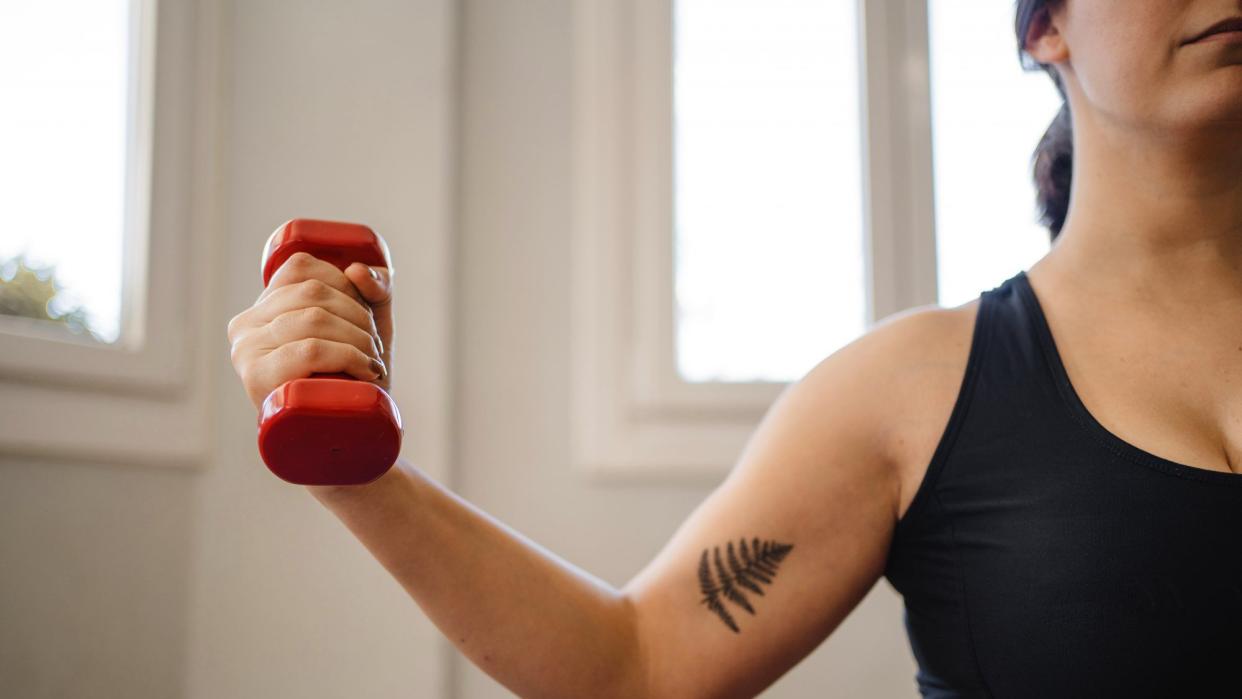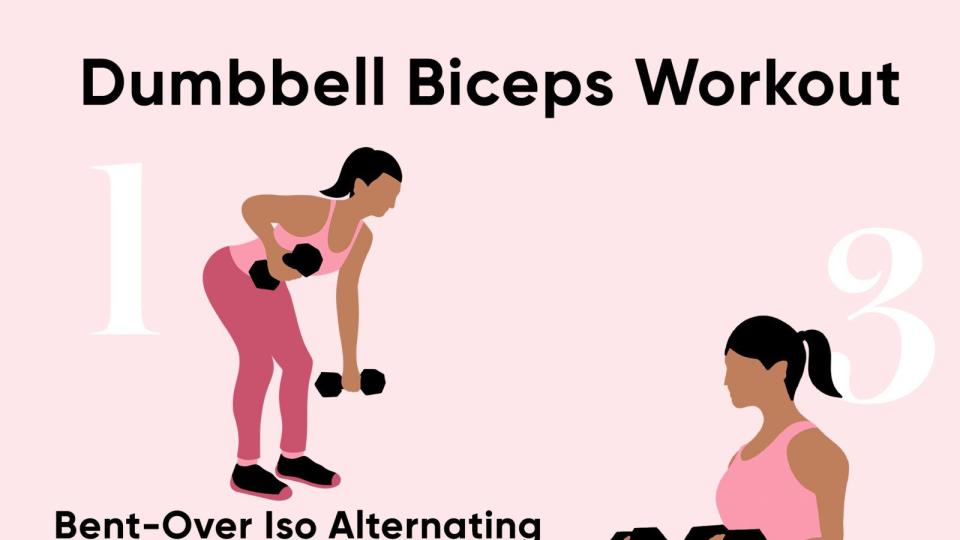This Simple Dumbbell Biceps Workout Will Help You Sculpt Stronger Arms

raquel arocena torres/Getty Images
Your biceps are often the centerpiece of having strong arms, and that's because they're the primary muscle involved in many everyday movements, including carrying heavy groceries and lifting your baby up and holding them. Strong biceps can also help you perform certain upper-body exercises more effectively.
"Having strong biceps will lead to more than just having a solid gun show pic," says Rafique "Coach Flex" Cabral, a NASM-certified personal trainer and Isopure athlete. "They assist in movements like rows, chin-ups, and pull-ups too."
That's right — if you want to perfect your pull-up or chin-up game, you're going to have to strengthen your biceps, which actually help with the pulling motion. So how can you build bigger and stronger biceps? Some of the best biceps exercises are those that isolate the muscles and make them do the brunt of the work.
Here, we break down the biceps muscles, how often to train them, and the most effective exercises for targeting your biceps. Plus, Cabral shares a quick dumbbell biceps workout you can do at home. (Related: The Challenging At-Home Arm Workout Without Any Push-Ups)
Biceps Muscles 101
The biceps muscles, aka the biceps brachii, are on the front of your upper arms. Their main action is to flex the elbow, bringing the forearm up toward the shoulder.
As their name suggests ("bi" means "two"), the biceps consists of two parts: the long and short heads. (Note: The head of a muscle is its point of origin, or where it is attached.) The long head of the bicep extends just a bit farther up the arm (toward the shoulder) than the short head of the bicep. They work in conjunction with the brachialis and brachioradialis muscles, which are also important elbow flexors and are crucial for isolating and working the biceps.
Depending on how you grip onto the dumbbells during a biceps workout with weights, you'll target either the long or short head of the biceps more. "Having a grip that's outside the shoulders, such as wide-grip bar curls and preacher curls, and having the elbows in front of the body will focus on the short head of the biceps," explains Cabral. "Conversely, having a more narrow grip and having your elbows start from behind the body, like a standing cable curl and incline hammer curl will build the long head." In order to grow bigger and stronger biceps, you need to work both heads so it's important to vary your exercises.
What Are the Best Biceps Exercises?
What are the most effective exercises for activating the biceps brachii? In an American Council on Exercise (ACE)-sponsored study, researchers evaluated the eight most popular bicep exercises with weights: the cable curl, barbell curl, concentration curl, chin-up, EZ curl, incline curl, and preacher curl. Results showed that, of this selection, the concentration curl was the most effective exercise for activating the biceps. FYI, the concentration curl is typically performed seated with knees wide and a dumbbell in one hand; you anchor the elbow of the working arm onto your thigh (so that the upper arm shouldn't be moving at all) and curl the weight up to your shoulder from there. This is an especially effective exercise to include in your biceps workout with weights because you're forcing your upper arm to stay still and moving only your forearm — with fewer muscles at play, it makes your biceps work harder.
He's also a fan of a squatted bicep curl — sitting in a squat position with your elbows pressed against your knees. It's a great way to simulate a preacher curl when you're performing a biceps workout with weights at home or don't have gym access. "The squatted curl puts emphasis on the short head of the biceps and simulates a preacher curl, which gives support behind the elbow for full extension of the bicep. Being able to take a muscle through its full range of motion is a great way to build functional strength," explains Cabral. (Also check out this at-home dumbell biceps workout that uses free weights, a resistance band, and a medicine ball.)
In a traditional biceps curl, the lack of support behind the elbow allows the arms to move more freely. "This allows you to cheat your way into more advantageous positions to get the weight up, taking away from the tension intended for the biceps," he says. By stabilizing the top of the arm, squatted curls, concentration curls, and preacher curls help prevent that.
During your biceps workout with weights, Cabral also recommends doing a 90-degree static hold while rotating your palms to face the floor and the sky (keep reading for a how-to). This 90-degree static hold keeps constant tension on the biceps and works another function of the biceps, which is the rotation of the forearms. (Related: The Super Sweaty 30-Day Arm Challenge That Will Sculpt Your Strongest Arms Ever)
Simple Dumbbell Biceps Workout
To help you follow a consistent training routine for your biceps, Cabral recommends doing biceps-focused exercises one to three times a week. "Choose a frequency depending on what your goals are. I recommend training them in conjunction with shoulder and back exercises. To train the biceps alone could lead to dysfunction, so having an integrated approach to training is key," says Cabral. (You could also structure your workouts push-pull style.)
Here, Cabral shares a dumbbell biceps workout you can do at home or at the gym with just one set of weights. Complete three to four rounds of this biceps workout with weights, or add these biceps exercises to your upper-body strength routine. As a general rule, when you use heavier weights and a lower rep range, you're building for strength and muscle hypertrophy. But when you use higher rep range and lighter weights, you're training for muscle endurance. (More here: What's the Difference Between Muscular Strength and Endurance?)

Eric Jeon
How it works: Do each of the biceps exercises below for the indicated number of reps. Repeat 3 to 4 rounds total.
You'll need: a set of medium-weight dumbbells
Bent-Over Iso Alternating Dumbbell Row
A. Stand with feet hip-width apart holding a dumbbell in each hand by sides.
B. With a slight bend in the knees, hinge forward at the hips until torso is between 45 degrees and parallel to the floor.
C. Maintaining a flat back and keeping shoulders square, row dumbbells up to ribs, squeezing shoulder blades together and drawing elbows straight back.
D. Keep one arm pinned to side while lowering the other weight down to return to start. Then, row the dumbbell back up to ribs and lower the other weight down.
Continue alternating for 10 to 20 reps.
Incline Hammer Curl
A. Sit on a bench and adjust the incline of the bench to about 45 degrees. Hold a dumbbell in each hand by sides with palms facing in. Keep shoulders back and down, and elbows close to torso.
B. Keeping upper arms, back, and shoulders still, lift the dumbbells toward shoulders, squeezing biceps at the top.
C. Slowly lower the weights down to return to start.
Do 8 to 15 reps.
Standing 90-Degree Hold with Rotation
A. Start standing with shoulders over hips and holding a dumbbell in each hand by sides with palms facing in. Roll shoulders back and down and avoid hunching them throughout the movement.
B. Lift the dumbbells until arms form 90-degree angles and keep elbows close to sides.
C. Keeping arms in this fixed position, rotate forearms so palms face the floor and then the ceiling.
Continue rotating the forearms for 30 to 45 seconds.

